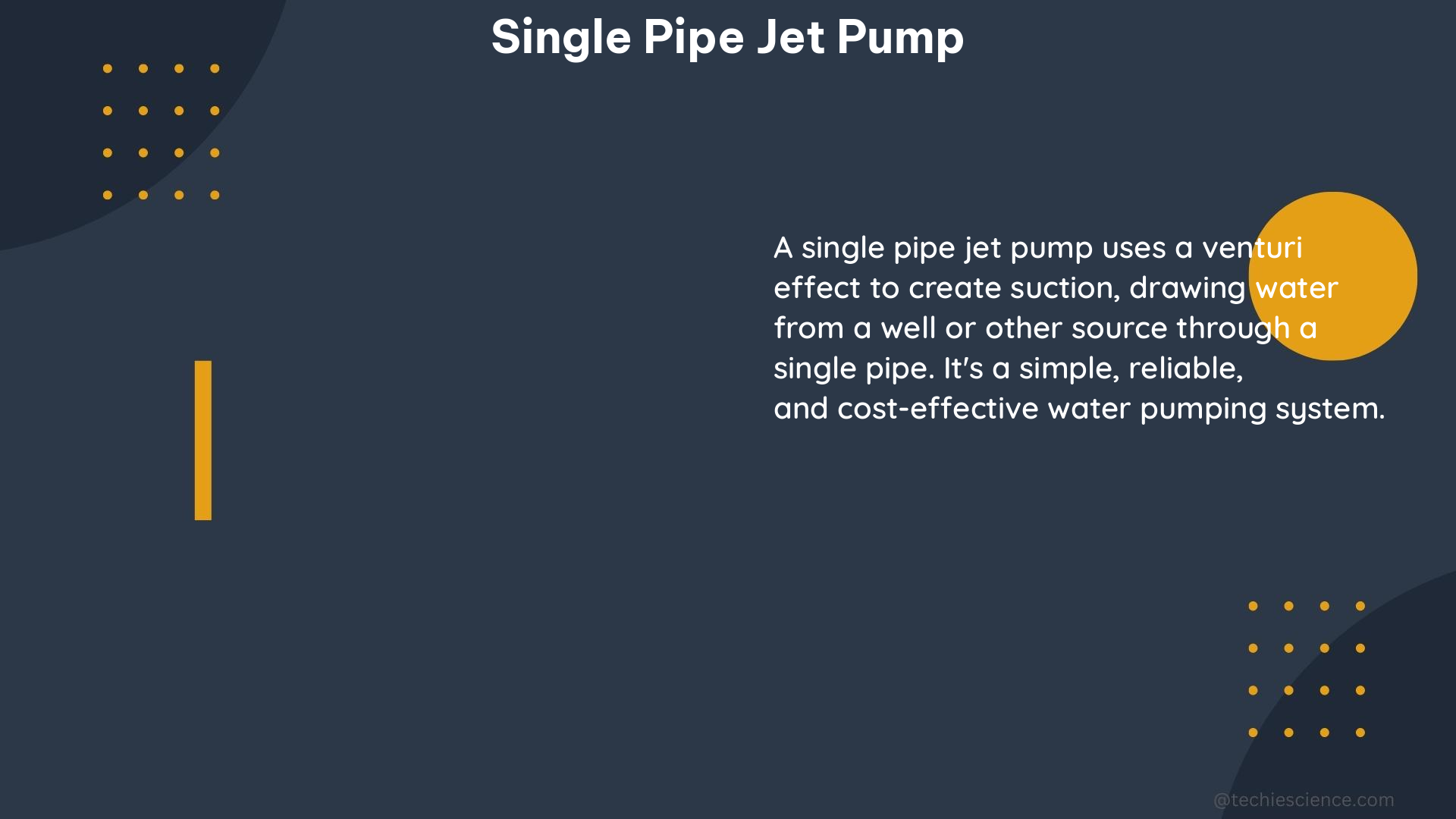A single pipe jet pump is a specialized water pump that utilizes a high-pressure stream of water to create a low-pressure area, effectively drawing water from a well or other water source. This ingenious design combines a centrifugal pump to generate the high-pressure stream and an ejector (or venturi) to establish the low-pressure zone, all within a single pipe configuration. Understanding the technical intricacies of these pumps is crucial for optimal installation, maintenance, and troubleshooting.
Technical Specifications of Single Pipe Jet Pumps
The technical specifications of single pipe jet pumps can vary significantly across manufacturers and models, but there are several key parameters that are commonly used to evaluate their performance:
Flow Rate
The flow rate, measured in gallons per minute (GPM), represents the volume of water the pump can move within a given time frame. This is a crucial factor in determining the pump’s suitability for your specific application. For example, the Flotec FP4012 1/2 HP Single-Drop Jet Pump boasts a flow rate of up to 12 GPM.
Pressure
The pressure, measured in pounds per square inch (PSI), reflects the force the pump can generate to overcome resistance and deliver water. Higher pressure capabilities enable the pump to lift water from greater depths or overcome longer pipe runs. The Flotec FP4012 model can generate up to 50 PSI of pressure.
Power
The power requirement, typically expressed in watts or horsepower (HP), indicates the electrical input needed to operate the pump. This specification is essential for ensuring the availability of a compatible power source and for calculating energy consumption. The Flotec FP4012 requires 550 watts of power.
Suction Lift
The suction lift, measured in feet, represents the maximum height the pump can draw water from the source. This parameter is particularly important for deep well applications, as the pump must be able to overcome the vertical distance to the water table. The Flotec FP4012 can handle a suction lift of up to 25 feet.
Efficiency
The efficiency, usually expressed as a percentage, reflects the ratio of the pump’s output power to its input power. Higher efficiency translates to lower energy consumption and operating costs. The Flotec FP4012 boasts an efficiency of up to 45%.
Installing and Maintaining Single Pipe Jet Pumps

Proper installation and maintenance are crucial for the optimal performance and longevity of single pipe jet pumps. Here are some key considerations:
Ejector Alignment
The ejector, located at the end of the single pipe, must be precisely aligned with the water source to ensure efficient operation. Misalignment can result in reduced flow rates and pressure, compromising the pump’s overall effectiveness.
Intake and Discharge Piping
The size and installation of the intake and discharge piping play a significant role in the pump’s performance. Undersized or improperly installed piping can lead to excessive pressure losses, limiting the flow rate and overall system efficiency.
Pressure Switch Adjustment
The pressure switch is responsible for turning the pump on and off at the appropriate pressure levels. Proper adjustment of the pressure switch is essential to prevent short-cycling and ensure the pump operates within its designed parameters.
Priming System Maintenance
Maintaining the pump’s priming system is crucial to prevent the loss of prime during operation. Neglecting the priming system can result in the pump failing to start or experiencing reduced performance.
Troubleshooting Single Pipe Jet Pumps
When encountering issues with your single pipe jet pump, such as low flow rates or pressure losses, there are several troubleshooting steps you can take:
- Inspect the Intake and Discharge Piping: Check for any leaks, blockages, or restrictions that may be impeding the flow of water.
- Evaluate the Ejector Alignment: Ensure that the ejector is properly aligned with the water source to optimize the low-pressure zone creation.
- Verify the Pressure Switch Operation: Confirm that the pressure switch is turning the pump on and off at the correct pressure levels.
- Examine the Priming System: Inspect the priming system for any issues that may be causing the pump to lose its prime.
- Review the Pump’s Technical Specifications: Compare the pump’s actual performance to its rated specifications to identify any discrepancies or potential problems.
By addressing these troubleshooting steps, you can effectively diagnose and resolve issues with your single pipe jet pump, ensuring optimal performance and longevity.
Conclusion
Single pipe jet pumps are a specialized and efficient solution for water pumping applications, particularly in deep well or challenging water source scenarios. Understanding the technical specifications, proper installation, maintenance, and troubleshooting procedures is crucial for ensuring the pump’s reliable and cost-effective operation. By following the guidelines outlined in this comprehensive guide, you can confidently tackle any challenges that may arise with your single pipe jet pump and maintain a well-functioning water delivery system.
References
- Single-Drop Jet Pumps – Flotec
- How a Jet Pump Works – The Spruce
- Jet Pump Troubleshooting – DoItYourself.com

The lambdageeks.com Core SME Team is a group of experienced subject matter experts from diverse scientific and technical fields including Physics, Chemistry, Technology,Electronics & Electrical Engineering, Automotive, Mechanical Engineering. Our team collaborates to create high-quality, well-researched articles on a wide range of science and technology topics for the lambdageeks.com website.
All Our Senior SME are having more than 7 Years of experience in the respective fields . They are either Working Industry Professionals or assocaited With different Universities. Refer Our Authors Page to get to know About our Core SMEs.